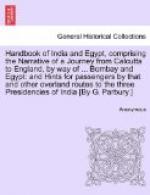As the day dawns, sturdy Hyderabad chorus-singers pass along the streets chanting the “prayers for the Prophet” in voices that awaken the denizens of the dark garrets and hidden courts of the teeming chals. And after them come the beggars of that class which is the peculiar product of Mahomedan life in Bombay. As the majority of the middle-class Musulmans and all the poorer class live in chals or “malas,” each family occupying one or at most two rooms in a building, the passages, corridors and staircases of these human warrens become the chosen paths of those astute mendicants who disdain not, when chance offers, to turn their hand to a little quiet thieving. Even as they fare upon their rounds, you catch the welcome call of the vendor of “jaleibi malpurwa,” who sells wheat-cakes fried rarely in ghi and generally in oil, and the “jaleibi” a sort of macaroni fried likewise in oil. These crisp cakes are a favourite breakfast-dish of the early-rising factory-operative, who finds himself thus saved the drudgery of cooking when he is barely awake and when moreover he is in a hurry to reach the scene of his daily labours. The vendor of these dainties is truly “a study in oils,” and his hands, which serve the purpose of knife and fork for the separation of his customers’ demands, drip—but not with myrrh. Though a vendor of oleaginous dainties, he is himself far from well-nourished. You can see his collar-bone and count his ribs and almost mark the beatings of his poor profit-counting heart. A dirty dhoti girds his loins, and upon his head is a turban of the same questionable hue which serves both as a head-dress and as a support for his tray of cakes. If a Musulman, he wears only a skullcap, a shirt or jacket and a pair of soiled baggy trousers. Once he has called, the jaleibi-vendor has a habit of presenting himself every day at the very hour when the children of the house begin to clamour for food, and calmly defies the angry order of the householder not to appear unless bidden.
Next comes the vendor of “chah, chah garam, chaaah garaaam” or hot tea, who is unusually an Irani. For having introduced tea into Western Asia the inhabitants of the land of “the gul and the bulbul” claim the secret of making a perfect infusion of the celestial leaves. He is no longer the embodiment of Tom Moore’s Heroic Guebre, this tea-vending Irani, and his apron forbids the suggestion that he has any association with Gao, the subverter of a monarchy and the slayer of the tyrant Zuhhac. He has sadly degenerated from the type of his Guebre ancestor. If he owns a shop he combines the sale of other commodities with the tea business. He has an ice-cream, a sherbet and a “cold-drink” department; and he touts for customers, singing the praises of hot and cold beverages in a language redolent of Persian. It does not pay him to use fresh tea-leaves from Kangra or China; so he purchases his stock from small traders, who in their turn obtain it as a bargain from butlers




